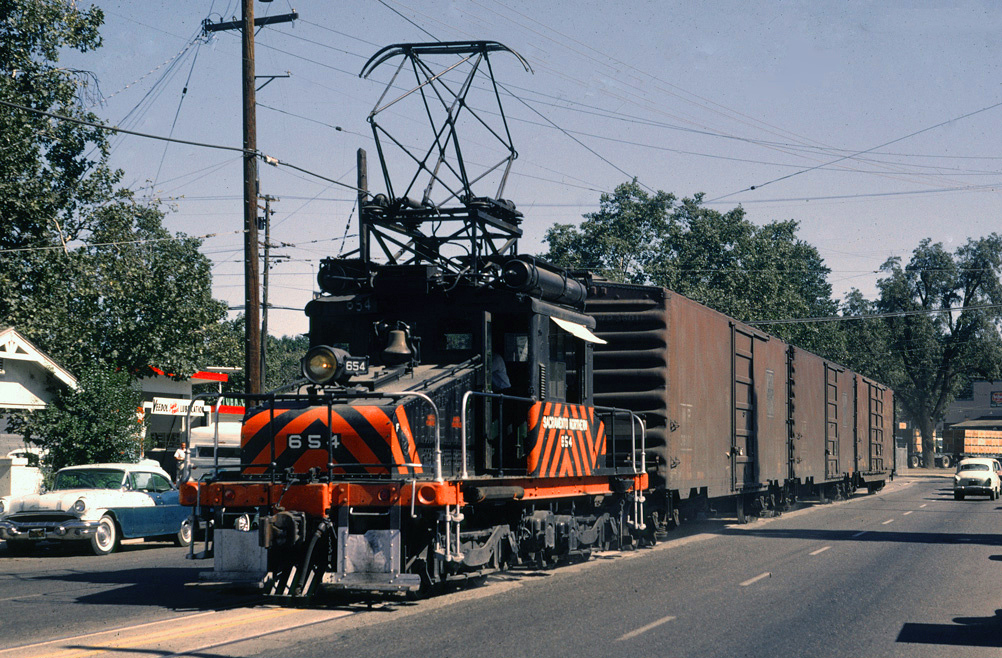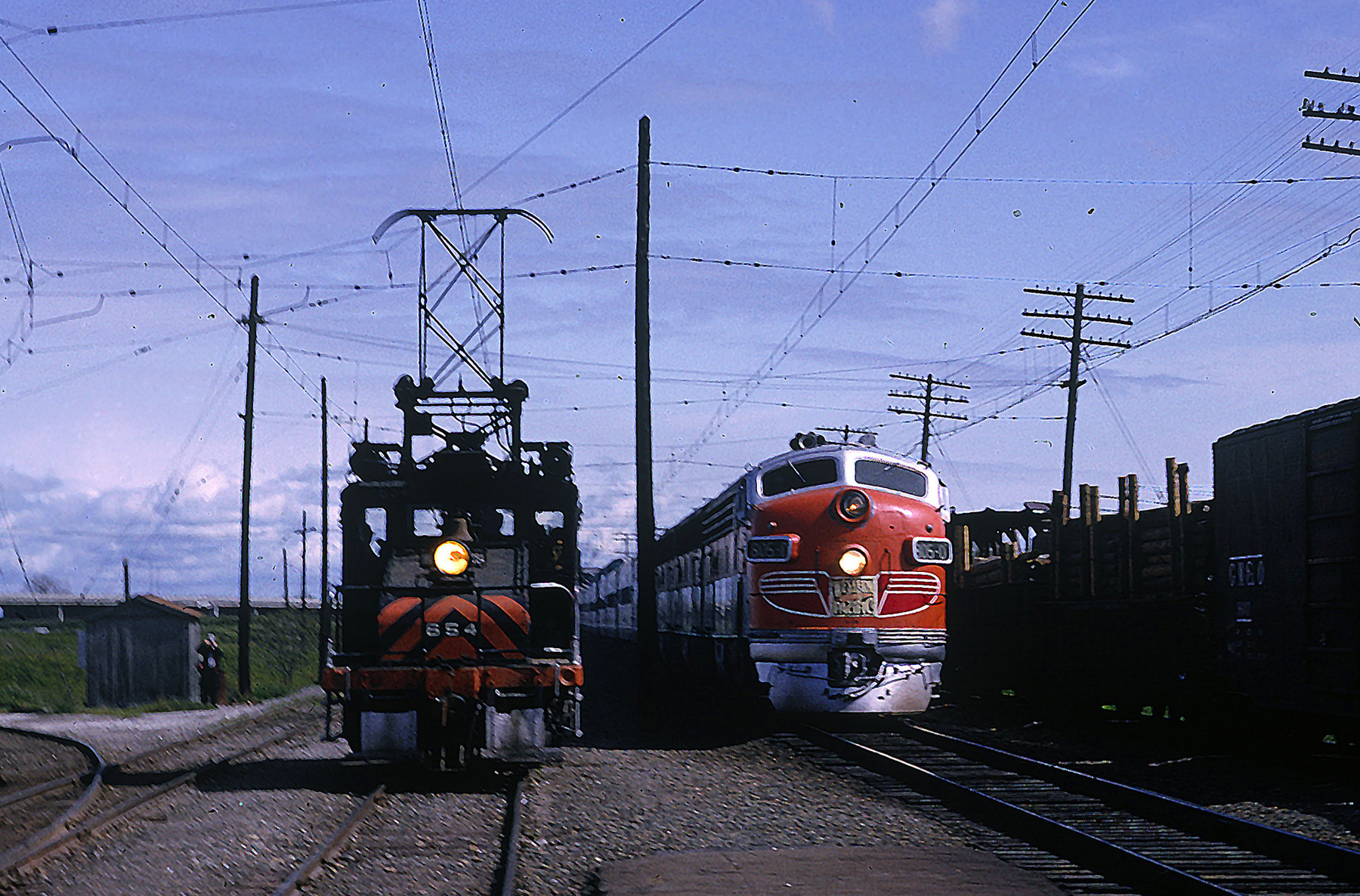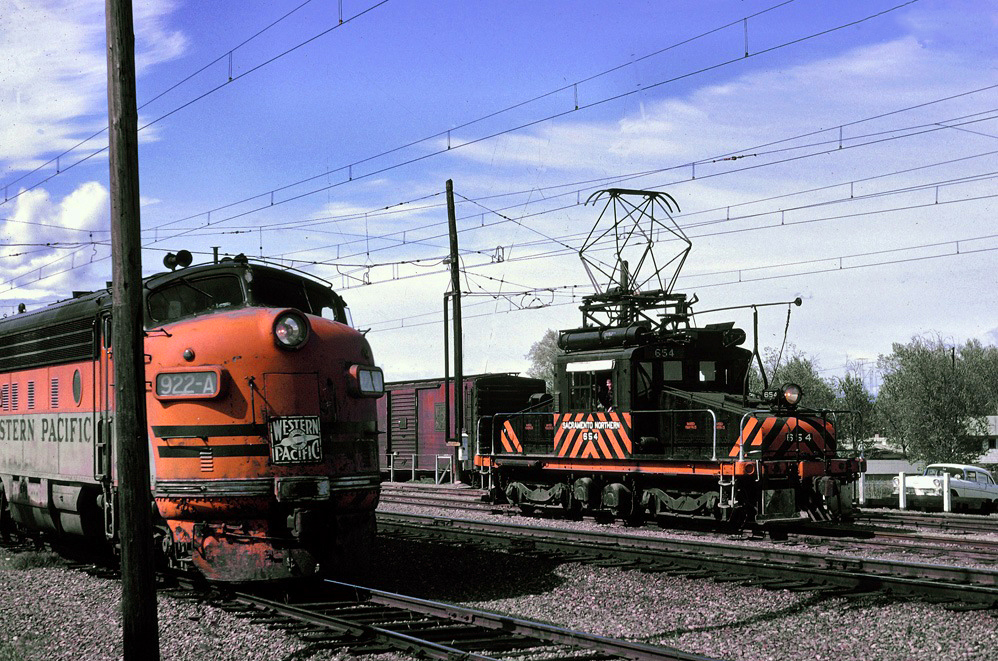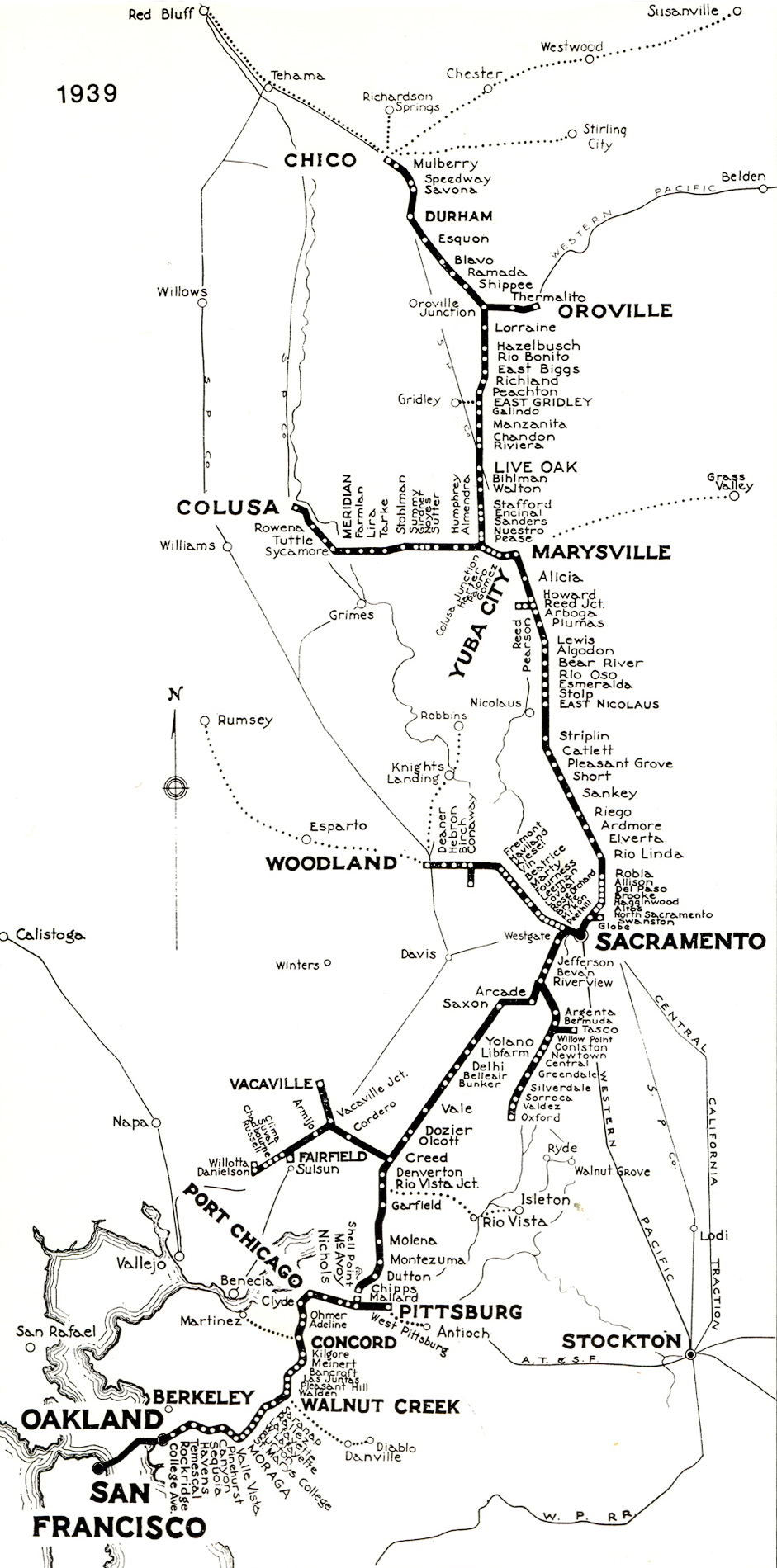Sacramento Northern Railway: Map, History, Photos
Last revised: September 7, 2024
By: Adam Burns
In terms of mileage and overall size the Sacramento Northern Railway was
one of the largest interurbans ever operated.
The SN served the San Francisco and Oakland area as well as points to the northeast stretching as far as Sacramento, Chico, and Hamilton City.
Its history dated as far back as the very early 1900s and consisted of a number of smaller interurbans and street railways that later were merged or purchased by larger companies.
While the SN name dated to 1914 for most of its existence it was under the control of the Western Pacific, one of California's largest main line systems.
Had it not been for WP ownership of the SN the interurban would likely have fallen apart along with the rest of the interurban industry after 1920.
The line concentrated on carload freight service strongly but was still feeling the effects of significant passenger traffic loss during the time period mentioned above.
As such, by the 1940s it had completely abandoned the service. Today, sections of the original SN remain in use by freight railroads, commuter lines, and even museums.
Photos
 Sacramento Northern steeple-cab #654 pulls boxcars out of the Del Monte plant in Yuba City, California on August 4, 1964. Drew Jacksich photo.
Sacramento Northern steeple-cab #654 pulls boxcars out of the Del Monte plant in Yuba City, California on August 4, 1964. Drew Jacksich photo.History
The Sacramento Northern Railway was composed primarily of two predecessor systems the Northern Electric Railway and the Oakland, Antioch & Eastern Railway.
The former line made up the SN's Northern Division while the latter its southern routes around Oakland and San Francisco.
The Northern Electric was incorporated in 1905 and soon afterwards, in 1906, purchased the Chico Electric Railway, a small streetcar system serving the small town of Chico.
The NE was funded and promoted by H.A. Butters who quickly set about building south towards Sacramento. Butters also constructed the interurban via a third-rail system for power, somewhat uncommon as most in the industry used a standard overhead wire for power pickup.
At A Glance
Oakland - Port Chicago - Sacramento - Marysville - Chico Creed - Willotta/Vacaville Riverview - Oxford Sacramento - Woodland Colusa Junction - Colusa Oroville Junction - Oroville | |
600 - 1,200 volt DC | |
In late April, 1906 the Northern Electric reached Oroville and by December that year it stretched to Marysville, about half-way to Sacramento.
Nearly a year later in early September, 1907 service was established to the city. This would prove to be the extent of the interurban's main line.
However, soon after opening it began constructing branches:
- In late October, 1907 the NE reached Hamilton City (northwest of Chico).
- July, 1912 saw service established to Woodland via Sacramento.
- By mid-June, 1913 a line was open to Colusa via Yuba City.
Overall, the Northern Electric operated about 93 miles of track, including its main line as well as branches.
The Southern Division of the SN was built originally by the Oakland & Antioch Railway. This interurban was funded by San Francisco businessmen and its name was soon changed to the Oakland, Antioch & Eastern.
The line started from near Oakland at Bay Point, where a connection was achieved with the Atchison, Topeka & Santa Fe Railway (the Santa Fe) and construction progressed eastward. In 1910 the OA&E reached Walnut and a year later was open to Lafayette.
By early April, 1913 the interurban had its main line open to Sacramento and a connection established with the Northern Electric. Unlike the NE, however, the OA&E was built to typical interurban standards of overhead wires for its power supply.
System Map (1939)
The OA&E soon added branches to its system that reached Danville and Pittsburg.
The OA&E was the hampered but a stiff main line given that it had to cross the Coast Range east of Oakland requiring grades of 3% as well as a 3,500 foot tunnel. The first Sacramento Northern Railroad was created in 1914 when the NE went into receivership.
However, the OA&E itself also fell into bankruptcy six years later in 1920 and was renamed the San Francisco-Sacramento Railroad, better known as the Sacramento Short Line.
In 1922 the Western Pacific Railroad decided to buy the SN, interested mostly for its potential freight volume around Sacramento.
Five years later the WP also was interested in the Short Line not only for its freight benefits but also recognized that it may use the two interurbans as its new through main line to Oakland.
While this never occurred, in 1928 the Sacramento Northern Railway was created as a holding company for the WP's new purchases (the lines were eventually merged into the new SN).
 Sacramento Northern steeple-cab #654 works the yard in Marysville, California as the "California Zephyr" hustles by in April, 1965. Drew Jacksich photo.
Sacramento Northern steeple-cab #654 works the yard in Marysville, California as the "California Zephyr" hustles by in April, 1965. Drew Jacksich photo.Under WP direction SN opened new branches to Clarksburg and Oxford and was finally able to reach downtown San Francisco in January, 1939 via the new Bay Bridge.
At its peak, the SN operated 183 miles of trackage. Interestingly, even under WP's control the Northern and Southern Divisions never received a unified power supply, each using their original third-rail and overhead systems.
Unfortunately, however, as early as 1924 lines were being shed due to low passenger traffic or insufficient freight potential.
First to go was the Danville Branch in 1924 followed by the Vacaville Branch in 1926. The Pittsburg Branch was abandoned in 1941 and in 1957 the entire main line west of Lafayette was shuttered after the WP built its own route into Oakland.
In terms of passenger service, even with the heavily populated region served, the SN could not compete with the fast growing highway system and the speedier routes offered by rival Southern Pacific.
 Western Pacific F7A #922-A slows with its freight as it passes Sacramento Northern steeple-cab #654 in the Marysville Yard in August of 1964. Drew Jacksich photo.
Western Pacific F7A #922-A slows with its freight as it passes Sacramento Northern steeple-cab #654 in the Marysville Yard in August of 1964. Drew Jacksich photo.In 1944 and 1945, after the final passenger services were discontinued the SN gave up its third-rail electrified operations in favor of standard diesel locomotives.
Interestingly, however, its overhead system (a combination of wiring and standard catenary) remained in use well into the 1960s before finally being removed by Western Pacific.
From an operational standpoint the Sacramento Northern was equipped to run between 600 and 1,200 volts, direct current (DC).
Despite the fact that the interurban was never a highly profitable system it was a very well maintained operation throughout both its independent years before WP ownership and afterwards.
With the SN's heavy equipment and well maintained right-of-way it was one of the smoothest rides via an interurban anywhere in the United States with speeds above 70 mph.
Final Years
Additionally, SN offered incredibly scenic views with glimpses of the San Francisco Bay around Oakland as well as bucolic rolling farmland north and south of Sacramento.
And of course, there was the nearby Coast Range mountains. The Western Pacific continued to operate portions of the SN throughout its independence until Union Pacific purchase the railroad.
Today, the UP still operates sections of the original Sacramento Northern Railway while other pieces of the system are used by commuter agency BART (Bay Area Rapid Transit).
Finally, the Western Railway Museum owns a 22-mile section of the main line between Rio Vista and Suisun City, part of which is again under wire and used for excursion service.
Recent Articles
-
Kentucky Dinner Train Rides In Bardstown!
Jan 13, 26 01:14 PM
The essence of My Old Kentucky Dinner Train is part restaurant, part scenic excursion, and part living piece of Kentucky rail history. -
Kansas Dinner Train Rides In Abilene!
Jan 13, 26 12:44 PM
If you’re looking for a heritage railroad that feels authentically Kansas—equal parts prairie scenery, small-town history, and hands-on railroading—the Abilene & Smoky Valley Railroad (A&SV) delivers. -
Michigan ~ Murder Mystery ~ Dinner Train Rides
Jan 13, 26 11:24 AM
Among the lesser-known treasures of this state are the intriguing murder mystery dinner train rides—a perfect blend of suspense, dining, and scenic exploration. -
Virginia's - Murder Mystery - Dinner Train Rides
Jan 13, 26 11:11 AM
Among the state's railroad attractions, murder mystery dinner trains stand out as a captivating fusion of theatrical entertainment, fine dining, and scenic travel. -
Arizona Dinner Train Rides At The Grand Canyon!
Jan 13, 26 10:59 AM
While the Grand Canyon Railway does not offer a true, onboard dinner train experience it does offer several upscale options and off-train dining. -
Georgia Dinner Train Rides In Nashville!
Jan 13, 26 10:27 AM
If you’ve ever wished you could slow down, trade traffic for jointed rail, and let a small-town landscape roll by your window while a hot meal is served at your table, the Azalea Sprinter delivers tha… -
Indiana Valentine's Train Rides
Jan 12, 26 04:27 PM
If you’ve ever wished you could step into a time when passenger trains were a Saturday-night treat and a whistle echoing across farm fields meant “adventure,” the Nickel Plate Express delivers that fe… -
Ohio Valentine's Train Rides!
Jan 12, 26 04:20 PM
The Hocking Valley Scenic Railway offers one of the region’s most atmospheric ways to experience the Hocking Hills area: from the rhythmic click of jointed rail to the glow of vintage coaches rolling… -
Wisconsin's - Wine Tasting - Train Rides
Jan 12, 26 03:10 PM
Wisconsin might not be the first state that comes to mind when one thinks of wine, but this scenic region is increasingly gaining recognition for its unique offerings in viticulture. -
California's - Wine Tasting - Train Rides
Jan 12, 26 02:34 PM
This article explores the charm, routes, and offerings of these unique wine tasting trains that traverse California’s picturesque landscapes. -
Wisconsin Scenic Train Rides In North Freedom!
Jan 12, 26 02:20 PM
The Mid-Continent Railway Museum is a living-history museum built around the sights, sounds, and everyday rhythms of small-town and shortline railroading in the early 20th century, what the museum cal… -
Vermont Scenic Train Rides In Burlington!
Jan 12, 26 01:18 PM
Today, GMRC is best known by many travelers for its Burlington-based passenger experiences—most famously the Champlain Valley Dinner Train and the sleek, limited-capacity Cocktails on the Rails. -
Maryland's - Murder Mystery - Dinner Train Rides
Jan 12, 26 01:03 PM
Maryland is known for its scenic landscapes, historical landmarks, and vibrant culture, but did you know that it’s also home to some of the most thrilling murder mystery dinner trains? -
Minnesota's - Murder Mystery - Dinner Train Rides
Jan 12, 26 12:17 PM
Murder mystery dinner trains offer an enticing blend of suspense, culinary delight, and perpetual motion, where passengers become both detectives and dining companions on an unforgettable journey. -
Vermont Dinner Train Rides In Burlington!
Jan 12, 26 12:09 PM
There is one location in Vermont hosting a dedicated dinner train experience at the Green Mountain Railroad. -
Connecticut Dinner Train Rides In Essex!
Jan 12, 26 10:39 AM
Connecticut's rail heritage can be traced back to the industry's earliest days and a few organizations preserve this rich history by offering train rides. The Essex Steam Train also hosts dinner-theme… -
Florida Scenic Train Rides In Parrish!
Jan 11, 26 10:26 PM
The Florida Railroad Museum (FRRM) in Parrish offers something increasingly rare in today’s rail landscape: a chance to ride historic equipment over a surviving fragment of an early-20th-century mainl… -
California's - Wine Tasting - Train Rides
Jan 11, 26 02:28 PM
This article explores the charm, routes, and offerings of these unique wine tasting trains that traverse California’s picturesque landscapes. -
Georgia's - Murder Mystery - Dinner Train Rides
Jan 11, 26 02:07 PM
In the heart of the Peach State, a unique form of entertainment combines the thrill of a murder mystery with the charm of a historic train ride. -
Colorado ~ Murder Mystery ~ Dinner Train Rides
Jan 11, 26 01:43 PM
Nestled among the breathtaking vistas and rugged terrains of Colorado lies a unique fusion of theater, gastronomy, and travel—a murder mystery dinner train ride. -
Minnesota Dinner Train Rides In Duluth!
Jan 11, 26 01:32 PM
One of the best ways to feel the region's history in motion today is aboard the North Shore Scenic Railroad (NSSR), which operates out of Duluth’s historic depot. -
Illinois Dinner Train Rides At Monticello!
Jan 11, 26 12:42 PM
The Monticello Railway Museum (MRM) is one of those places that quietly does a lot: it preserves a sizable collection, maintains its own operating railroad, and—most importantly for visitors—puts hist… -
Alabama's - Wine Tasting - Train Rides
Jan 10, 26 09:29 AM
While the state might not be the first to come to mind when one thinks of wine or train travel, the unique concept of wine tasting trains adds a refreshing twist to the Alabama tourism scene. -
Maryland Dinner Train Rides At WMSR!
Jan 10, 26 09:13 AM
The Western Maryland Scenic Railroad (WMSR) has become one of the Mid-Atlantic’s signature heritage operations—equal parts mountain railroad, living museum, and “special-occasion” night out. -
Arkansas Dinner Train Rides On The A&M!
Jan 10, 26 09:11 AM
If you want a railroad experience that feels equal parts “working short line” and “time machine,” the Arkansas & Missouri Railroad (A&M) delivers in a way few modern operations can. -
South Dakota's - Murder Mystery - Dinner Train Rides
Jan 10, 26 09:08 AM
While the state currently does not offer any murder mystery dinner train rides, the popular "1880 Train" at the Black Hills Central recently hosted these popular trips! -
Wisconsin's - Murder Mystery - Dinner Train Rides
Jan 10, 26 09:07 AM
Whether you're a fan of mystery novels or simply relish a night of theatrical entertainment, Wisconsin's murder mystery dinner trains promise an unforgettable adventure. -
Missouri's - Murder Mystery - Dinner Train Rides
Jan 10, 26 09:05 AM
Missouri, with its rich history and scenic landscapes, is home to one location hosting these unique excursion experiences. -
Washington ~ Murder Mystery ~ Dinner Train Rides
Jan 10, 26 09:04 AM
This article delves into what makes murder mystery dinner train rides in Washington State such a captivating experience. -
Kentucky Scenic Train Rides At KRM!
Jan 09, 26 11:13 PM
Located in the small town of New Haven the Kentucky Railway Museum offers a combination of historic equipment and popular excursions. -
Washington "Wine Tasting" Train Rides
Jan 09, 26 08:53 PM
Here’s a detailed look at where and how to ride, what to expect, and practical tips to make the most of wine tasting by rail in Washington. -
Kentucky's - Wine Tasting - Train Rides
Jan 09, 26 08:21 PM
Kentucky, often celebrated for its rolling pastures, thoroughbred horses, and bourbon legacy, has been cultivating another gem in its storied landscapes; enjoying wine by rail. -
Kentucky's - Murder Mystery - Dinner Train Rides
Jan 09, 26 01:12 PM
In the realm of unique travel experiences, Kentucky offers an enchanting twist that entices both locals and tourists alike: murder mystery dinner train rides. -
Utah's - Murder Mystery - Dinner Train Rides
Jan 09, 26 01:05 PM
This article highlights the murder mystery dinner trains currently avaliable in the state of Utah! -
North Carolina Dinner Train Rides At NCTM!
Jan 09, 26 12:51 PM
Tucked into the Piedmont town of Spencer, the North Carolina Transportation Museum is the kind of place that feels less like a typical museum and more like a living rail yard that never quite stopped… -
Tennessee Dinner Train Rides At The TVRM!
Jan 09, 26 12:39 PM
Tucked into East Chattanooga, the Tennessee Valley Railroad Museum (TVRM) is less a “museum you walk through” and more a railroad you step aboard. -
New York Scenic Train Rides On The A&A!
Jan 09, 26 11:20 AM
The A&A is both a common-carrier short line moving freight and a heritage railroad hosting popular excursion trains, all on the same storied right-of-way. -
Pennsylvania Scenic Train Rides In Hollidaysburg!
Jan 09, 26 11:14 AM
Tucked into the Juniata River valley just south of Altoona, the Everett Railroad offers one of the most approachable—and photogenic—heritage-rail experiences in Pennsylvania -
Montana Dinner Train Rides Near Lewistown!
Jan 08, 26 03:03 PM
The Charlie Russell Chew Choo turns an ordinary rail trip into an evening event: scenery, storytelling, live entertainment, and a hearty dinner served as the train rumbles across trestles and into a t… -
Alabama's - Murder Mystery - Dinner Train Rides
Jan 08, 26 02:19 PM
There is currently one location in the state offering a murder mystery dinner experience, the Wales West Light Railway! -
Rhode Island's - Murder Mystery - Dinner Train Rides
Jan 08, 26 01:43 PM
Let's dive into the enigmatic world of murder mystery dinner train rides in Rhode Island, where each journey promises excitement, laughter, and a challenge for your inner detective. -
Florida's - Wine Tasting - Train Rides
Jan 08, 26 01:13 PM
Wine by train not only showcases the beauty of Florida's lesser-known regions but also celebrate the growing importance of local wineries and vineyards. -
Texas's - Wine Tasting - Train Rides
Jan 08, 26 12:30 PM
This article invites you on a metaphorical journey through some of these unique wine tasting train experiences in Texas. -
New York's - Wine Tasting - Train Rides
Jan 08, 26 11:32 AM
This article will delve into the history, offerings, and appeal of wine tasting trains in New York, guiding you through a unique experience that combines the romance of the rails with the sophisticati… -
California Dinner Train Rides In Sacramento!
Jan 08, 26 11:21 AM
Just minutes from downtown Sacramento, the River Fox Train has carved out a niche that’s equal parts scenic railroad, social outing, and “pick-your-own-adventure” evening on the rails. -
New Jersey Dinner Train Rides In Woodstown!
Jan 08, 26 10:31 AM
For visitors who love experiences (not just attractions), Woodstown Central’s dinner-and-dining style trains have become a signature offering—especially for couples’ nights out, small friend groups, a… -
Nevada's - Murder Mystery - Dinner Train Rides
Jan 07, 26 02:12 PM
Seamlessly blending the romance of train travel with the allure of a theatrical whodunit, these excursions promise suspense, delight, and an unforgettable journey through Nevada’s heart. -
West Virginia's - Murder Mystery - Dinner Train Rides
Jan 07, 26 02:08 PM
For those looking to combine the allure of a train ride with an engaging whodunit, the murder mystery dinner trains offer a uniquely thrilling experience. -
Kansas's - Murder Mystery - Dinner Train Rides
Jan 07, 26 01:53 PM
Kansas, known for its sprawling wheat fields and rich history, hides a unique gem that promises both intrigue and culinary delight—murder mystery dinner trains. -
Michigan's - Wine Tasting - Train Rides
Jan 07, 26 12:36 PM
In this article, we’ll delve into the world of Michigan’s wine tasting train experiences that cater to both wine connoisseurs and railway aficionados.















































